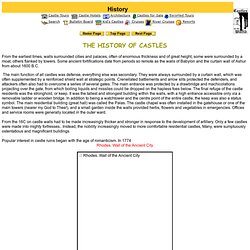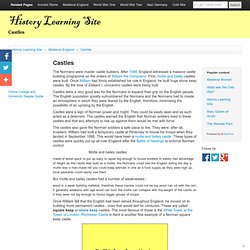

Castle. A European innovation, castles originated in the 9th and 10th centuries, after the fall of the Carolingian Empire resulted in its territory being divided among individual lords and princes.

These nobles built castles to control the area immediately surrounding them, and were both offensive and defensive structures; they provided a base from which raids could be launched as well as protection from enemies. Although their military origins are often emphasised in castle studies, the structures also served as centres of administration and symbols of power.
Urban castles were used to control the local populace and important travel routes, and rural castles were often situated near features that were integral to life in the community, such as mills and fertile land. Many castles were originally built from earth and timber, but had their defences replaced later by stone. Definition Etymology Defining characteristics Terminology Common features Motte A motte was an earthen mound with a flat top. Keep. History. From the earliest times, walls surrounded cities and palaces, often of enormous thickness and of great height, some were surrounded by a moat, others flanked by towers.

Some ancient fortifications date from periods so remote as the walls of Babylon and the curtain wall of Ashur from about 1600 B.C. The main function of all castles was defense, everything else was secondary. They were always surrounded by a curtain wall, which was often supplemented by a reinforced shield wall at strategic points.
Crenellated battlements and arrow slits protected the defenders, and attackers often also had to overcome a series of several gates. The main entrance was protected by a drawbridge and machicolations projecting over the gate, from which boiling liquids and missiles could be dropped on the hapless foes below. From the 16C on castle walls had to be made increasingly thicker and stronger in response to the development of artillery. . Rhodes. Castles. The Normans were master castle builders.

After 1066, England witnessed a massive castle building programme on the orders of William the Conqueror. First, motte and bailey castles were built. Once William had firmly established his rule in England, he built huge stone keep castles. By the time of Edward I, concentric castles were being built. Castles were a very good way for the Normans to expand their grip on the English people. Castles were a sign of Norman power and might. The castles also gave the Norman soldiers a safe place to live.
Motte and bailey castles: made of woodquick to put upeasy to repairbig enough to house soldiers in safetyhad advantage of height as the castle was built on a motte; the Normans could see the English during the daya motte was a man-made hillyou could keep animals in one as a food supplyas they were high up, local peasants could easily see them But motte and bailey castles had a number of weaknesses : Square keep castles: made of stone so they lasted longer. Ballygally Castle. Ballygally Castle is in the village of Ballygally, County Antrim, Northern Ireland, located approximately three miles north of Larne.

The castle overlooks the sea at the head of Ballygally Bay. Now run as a hotel, it is the only 17th century building still used as a residence in Northern Ireland, and is reputed to be one of the most haunted places in the province.[1] Features[edit] The castle is described as "a living postcard—a charming, almost teal-colored Scottish baronial castle overlooking the sea in Northern Ireland. History[edit] The castle was built in 1625 by James Shaw, of Scotland, who had come to the area and rented the land from the Earl of Antrim for £24 a year.[5] Over the main entrance door to the castle, leading to the tower, is the Middle Scots inscription "Godis Providens is my Inheritans".[4] The castle did come under attack, from the Irish garrison at Glenarm, several times during the rebellion of 1641 but each assault was unsuccessful.
Reputed hauntings[edit] Great Medieval Castles of Wales - Medieval Architecture Jewels. The Castles of Wales. Castles of Britain.